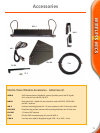
90
In 1934, Electro-Voice invented the hum-bucking coil for micro-
phones, still an industry standard almost 70 years later. The inven-
tion was the beginning of EV’s success in building microphones,
but not the end. Electro-Voice continues to set new standards for
microphone design today. Electro-Voice was the first manufacturer
to use neodymium-based magnet structures (N/DYM
®
) in its
microphones, thus achieving higher output and condenser-like
qualities such as crystal clarity and reliable performance. Electro-
Voice’s goals in developing microphone technologies have always
been the same: providing highest sound quality, achieving better
and more comfortable handling for the user, and continuing the
company’s tradition of legendary reliability and warranty support.
Its long list of patents attests to its success in meeting these goals.
Variable-D
®
Normal microphones generate increased bottom end when used
close up. This is typically called the “proximity effect.” While some
lead vocalists like this effect and use it to enhance their perform-
ance, it is attainable only in closeup situations. When the distance
between the microphone and the source is extended, the sound
quality changes dramatically. Electro-Voice’s patented Variable-D
®
eliminates this disadvantage. On the rear side of the diaphragm
there is a perforated pipe (interference duct) with precise sonic slots
at set distances. The duct provides maximum damping which is
completely uncoloured and undistorted at 180-degree off-axis,
ensuring the same frequency response as if the source was nearly
on-axis.
Variable-D
®
designed microphones can be used very close to other
sound sources with no loss in clarity or definition. This makes them
the preferred choice for tight vocals and challenging instruments
such as brass. Variable-D
®
microphones like the RE20 and RE27 are
favorites with broadcast show hosts, vocal booths, voice-over stu-
dios, and professional touring or rental companies.
VOB
™
Electro-Voice’s unique VOB™ technology (Vocal-Optimized Bass)
reduces low-frequency distortion in the microphone’s output. Critical
damping of the low-frequency resonant peak results in a microphone
that replaces the “muddiness” found in competitive models with
greater warmth and increased vocal intelligibility. With a wider range
of working distances than other microphones, this intelligibility
ensures a clean, clear, consistent sound that “cuts through the mix.”
VOB™ counteracts proximity effect, sibilance, and P-popping, thus
assuring maximum vocal intelligibility and musical clarity.
with VOB™
without VOB™
Normal mic Variable-D
®
mic
Microphone Technologies
PIN - Arrangements
Electronic
Microphones
TA4F (not shown)
used in N/DYM
wireless
Pin 1: Common
Pin 2: Audio
Pin 3: Bias
Pin 4: Not used
Balanced (XLR)
Pin 1: Shield
Pin 2: Signal +
Pin 3: Signal -
Balanced (XLR)
Pin 1: Shield
Pin 2: Hot
Pin 3: Cold
Pin 5: common
Pin 6: parallel to 1 + 4
Pin 7: parallel to 8
Pin 8: parallel to 7
Fullrange Pin 1: LF/HF +/-
Pin 2: Not connected
Biamp Pin 1: LF
Section +/-
Pin 2: HF Section +/-
Subwoofer Pin 1: LF input +/-
System
Pin 1 in:
LF +/- Pin 2! out
Pin 2 in:
LF +/- Pin 1! out
Pin 3 in:
MB+/- Pin 3 out
Pin 4 in:
HF +/-
Pin 4 out
Pin 1: parallel to 4 + 6
Pin 2: TxD
Pin 3: RxD
Pin 4: parallel to 1 + 6
PC inter
face
(RS 232)
Speakers
male female


















